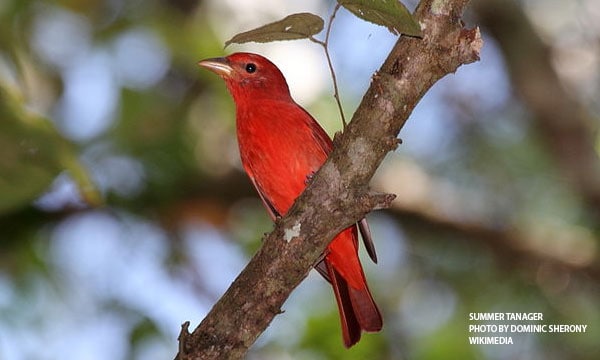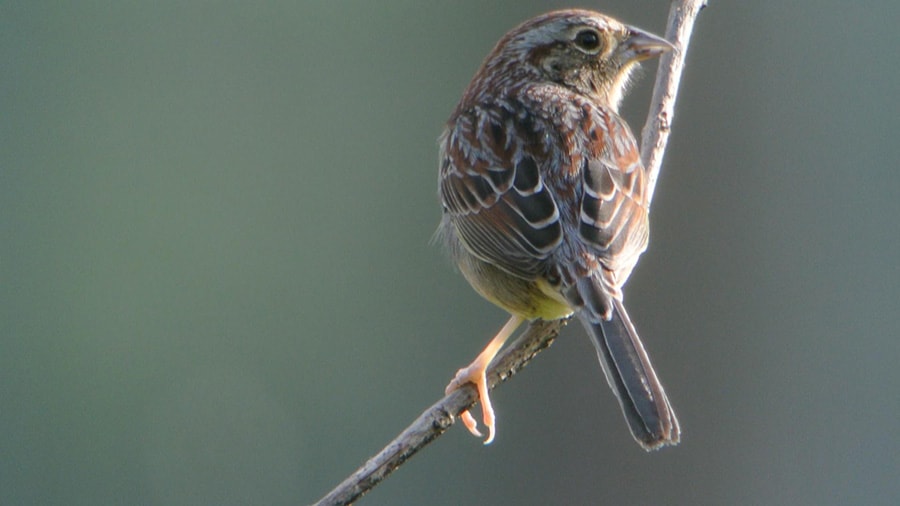Summer Birds of Ohio (June, July, August)
June brings the onset of summer and the breeding season in Ohio, but the latest of our migrants still trickle through to points far to the north. The first week of June is a good time to look for Connecticut warbler, yellow-bellied flycatcher, and Philadelphia vireo, if you can see them in the now fully expanded leaves of our woods. Of course, many species of shorebirds, not yet in a hurry to reach their high-arctic nesting grounds, filter through. Wherever suitable mudflats are available, you can be sure that a number of sandpipers and plovers will be busily scurrying about, packing on body fat to sustain them for the long flight that remains.
But what really characterizes June is the breeding season for our songbirds. About 180 species of birds breed in Ohio each year, and just over one-third of these are neotropical migrants—birds that breed here but winter in Central and South American tropics. This group includes most of our warbles, vireos, thrushes, flycatchers, orioles, and tanagers, among others. As the majority of these species are forest nesters, Ohio plays a big role in their life cycle. At the time of European settlement, Ohio was densely cloaked with primeval woodlands, covering about 95 percent of the state. While we certainly no longer have that type of forest coverage, about 1/3rd of Ohio is currently wooded. Some of the greatest remaining concentrations of forest birds, like the cerulean warbler, are now found in the Buckeye State.
The great forests of unglaciated southern and eastern Ohio is the place to go to get a flavor for our woodland songsters. Many vast forested tracts have been protected here, and in early June the woods will be alive with the haunting, ethereal tones of the wood thrush, the persistent and loud teacher-teacher-TEACHER of the ovenbird, and the obscure dry trills of the worm-eating warbler. One of the great experiences to be had birding in Ohio is to experience the dawn chorus of songsters in a huge woodland like Shawnee State Forest. The sheer numbers and diversity of singers will dumbfound an observer in June, as the territorial males loudly proclaim their fitness as mates and providers.
This is a time of year that really demonstrates the importance of learning bird songs. While virtually all of our songbirds are in full tune and easily heard, seeing them can be another matter altogether, as the leaf canopy of Ohio’s forests can be as dense as a tropical rainforest. Knowing the calls allows an observer to track down and view that beautiful hooded warbler or black-billed cuckoo lurking in the undergrowth, and the song-savvy birder will detect 10 times as many birds at this time of year.
Our grasslands come alive this time of year, and a place like The Wilds is transformed into a noisy, bubbling cacophony of bobolinks, eastern meadowlarks, and other birds of wide-open spaces. As one’s senses become adapted to the sounds of the grasslands, the more subtle sounds of the prairie birds will come into focus. The two-pitched trill of Savannah sparrows vie with the more monotone, jangly trills of grasshopper sparrows, and careful searching will often reveal these birds perched on a fence post or tall weed. But the one to really cup your ears and listen for is the Henslow’s sparrow, which is at the peak of activity in June. These chunky little sparrows’ hiccup-like song is easily lost among the bolder residents of the grasslands, but keying on their call is about the only way to eventually spot on of these skulkers.
As June rolls into July, days become hotter, birds become more sluggish, and activity lessens. Many of our songbirds have already fledged young, and may even be starting a second brood. Now, its imperative to get afield at the crack of dawn to really hear the singers, as bird song really slows and becomes intermittent as July goes on.
Some of our bird species are in the habitat of making late arrivals, though, and often don’t even show up until July. The sedge wren is a little grassland wren that is notorious for showing up in mid-summer, possibly after they’ve already nested somewhere in the prairies farther to the west. Countering the sedge wren’s lateness is a group of birds that makes an astonishingly early appearance. A number of shorebirds, such as semipalmated plover, least sandpiper, and short-billed dowitcher routinely appear in Ohio by the first or second week of July. These are birds that have already been to the Arctic of Canada and attempted to breed, and are winging their way back south. It’s likely these extreme early birds failed in their first nesting attempts, and the very brief Arctic summer doesn’t allow time for a second chance.
The dog days of August might be regarded as the dullest month for birding in Ohio, and the heat, insects, and dense vegetation of late summer don’t help with the appeal. But, there’s still birding action to be had, of course, and shorebirds are the highlight of this month. Ohio plays an important role in providing stopover resting and foraging areas for this amazing group of transglobal wanderers, many of which nest in the Arctic reaches near the top of the globe, and migrate to the southern reaches of South America. The trick is finding suitable mudflat habitats, which vary in location from year to year, but generally, the large marshes of western Lake Erie are best.
An impressive 47 species of sandpipers, plovers, godwits, and other shorebirds have been spotted along Lake Erie, and August brings peak diversity. The astute observer will note that most shorebirds are adults this time of year; they leave the northern breeding grounds first, leaving the young to fend for themselves. The juveniles pass through about a month after the adults. Mudflat-watching is easy birding, in the sense that the birder doesn’t have to move around much and the birds are often nicely arrayed right out in front, making for easy study. However, many birders regard shorebirds as one of the trickier groups of birds to learn, and having a good spotting scope is extremely helpful for studying their finer points.




